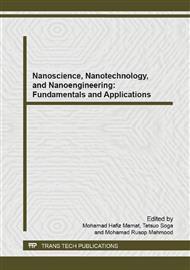[1]
N. Itoh, in functional Thin Films and Functional Materials: New Concept and Technologies, ed. D.L. Shi, Tsinghua University Press and Springer-verlag, bErlin, 2003, p.1.
Google Scholar
[2]
Zhiyong Fan & Jia G. Lu. Zinc Oxide Nanostructures : Synthesis and Properties, Department of Chemical Engineering and Material Science & Department of Electrical Engineering and Computer Science, University of California, Irvine, CA 92697, USA, (2005).
DOI: 10.31526/lhep.2.2019.113
Google Scholar
[3]
S. Araki, Z. Min, T. Doe, L. Li, M. Horita, T. Nishida, et al., Fabrication of nano-patterns using quick gel-nanoimprint process, in Future of Electron Devices, Kansai (IMFEDK), 2012 IEEE International Meeting for, 2012, pp.1-2.
DOI: 10.1109/imfedk.2012.6218583
Google Scholar
[4]
A. Janotti & C. G. Van de Walle, Fundamentals of Zinc Oxide as A Semiconductor, Materials Department, University of California, Santa Barbara, CA 93106-5050, USA, 22 Oct (2009).
Google Scholar
[5]
Zhiyong Fan & Jia G. Lu. Zinc Oxide Nanostructures : Synthesis and Properties, Department of Chemical Engineering and Material Science & Department of Electrical Engineering and Computer Science, University of California, Irvine, CA 92697, USA. 7 Jan (2005).
DOI: 10.31526/lhep.2.2019.113
Google Scholar
[6]
Y Yi-Joe Pon; Chih-Hsiung Shen; Shu-Jung Chen, A low cost high sensitivity CMOS MEMS gas sensor, , Instrumentation and Measurement Technology Conference I2MTC), 2010 IEEE, vol., no., 3-6 May 2010, p.564, 567.
DOI: 10.1109/imtc.2010.5488078
Google Scholar
[7]
Nargis Bano, Fabrication and Characterization of ZnO Nanorods Based Intrinsic White Light Emitting Diodes (LEDs), Linkoping Studies in Science and Technology, (2011).
Google Scholar
[8]
Comini, E., Metal oxide nanowires gas sensors, Electronics, Circuits and Systems, 008. ICECS 2008. 15th IEEE International Conference on, vol., no., Aug. 31 2008-Sept. 3 2008, p.13, 15.
DOI: 10.1109/icecs.2008.4675126
Google Scholar
[9]
Funakubo, Hiroshi, N. Mizutani, M. Yonetsu, A. Saiki, and K. Shinozaki, Orientation of Control of ZnO Thin Films Prepared by CVD, Journal of Electroceramics 4, no. 1, 1999, pp.25-32.
DOI: 10.1023/a:1009965432447
Google Scholar
[10]
S. Mridha and D. Basak, Effect of Thickness on the Structural, Electrical, and Optical Properties of ZnO films, Material research bulletin 42, no. 5, 2007, pp.875-882.
DOI: 10.1016/j.materresbull.2006.08.019
Google Scholar
[11]
Chen, J. J., F. Zeng, D. M. Li, J. B. Niu, and F. Pan, Depostion of High-Quality Zinc Oxide Thin Films on Diamond Substrates for High-Frequency Surface Acoustic Wave Filter Applications, Thin Films 485, no. 1, 2005, pp.257-261.
DOI: 10.1016/j.tsf.2005.04.028
Google Scholar
[12]
Ozgur, U.; Hofstetter, Daniel; Morkoc, Hadis, ZnO Devices and Applications: A Review of Current Status and Future Prospects, Proceedings of the IEEE, vol. 98, no. 7, July 2010, p.1255, 1268.
DOI: 10.1109/jproc.2010.2044550
Google Scholar
[13]
Bandyopadhyay, S., G. k. Paul, R. Roy, S. k. Sen, and S. Sen. Study of Structural and Electrical Properties of Grain-boundary Modified ZnO Films Prepared by Sol–gel Technique., Materials Chemistry and Physics 74. 1, 2002 pp.83-91.
DOI: 10.1016/s0254-0584(01)00402-3
Google Scholar
[14]
Harish Bahadur, A K Srivasta, Divi Haranath, Harish Chander, A Basu, S B Samanta, K N Sood, Ram Kishore, R K Sharma, Rashmi, Vivekanand Bhatt, Prem Pal & Sudhir Chandra. Nano-structured ZnO films by sol-gel process,. National Physical Laboratory. Dr K S Krishnan Road. New Delhi 110012, 4 January (2007).
DOI: 10.1049/cp:20040825
Google Scholar
[15]
F Chen, Cheng-Ying, et al. Surface effects on optical and electrical properties of ZnO nanostructures., Pure and Applied Chemistry 82. 11 (2010): 2055-(2073).
Google Scholar
[16]
M.H. Mamat, M.Z. Sahdan, Z. Khusaimi, A.Z. Ahmed, S. Abdullah, M. Rusop, Influence of doping concentrations on the aluminum doped zinc oxide thin films properties for ultraviolet photoconductive sensor applications, Optical Materials 32 (2010).
DOI: 10.1016/j.optmat.2009.12.005
Google Scholar
[17]
Richard C. Jaeger. Introduction to microelectronic fabrication, volume V, 2002, pp.136-141.
Google Scholar
[18]
Micheal Quirk, Julian Serda, " Semiconductor Manufacturing Technology, 2001, p.29.
Google Scholar


